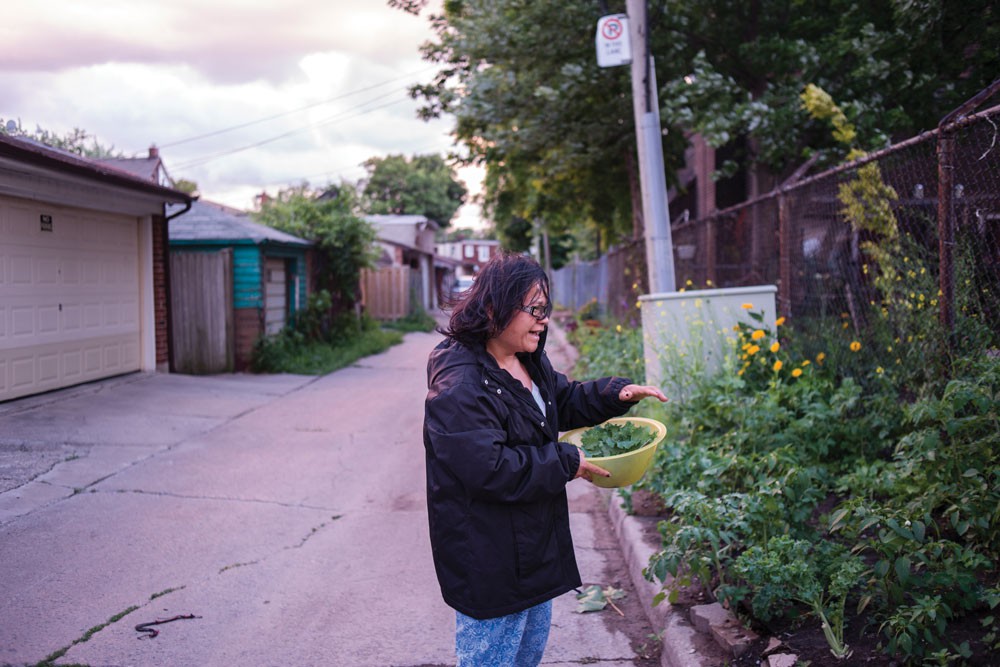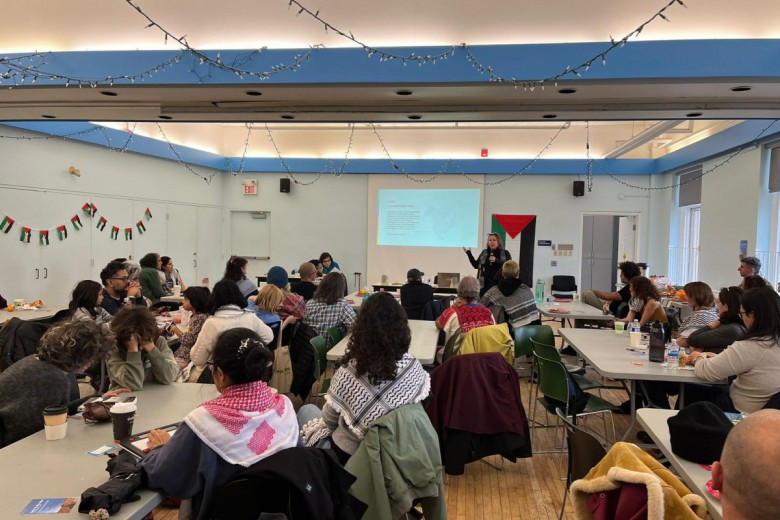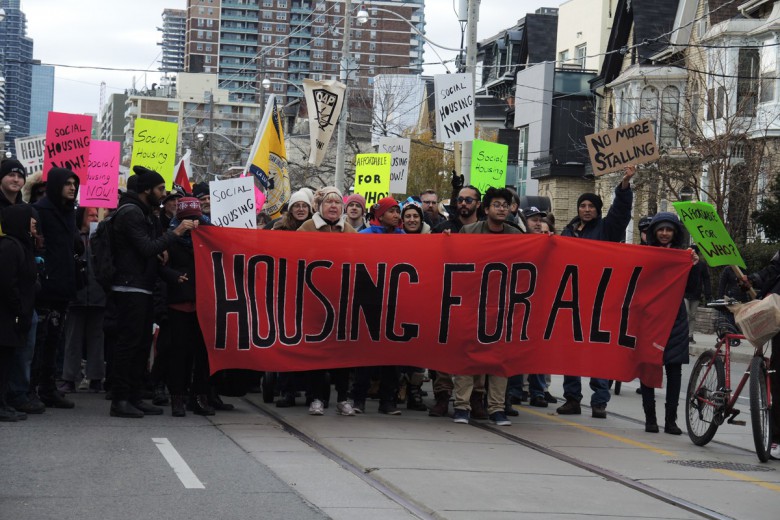_1000_667_90.jpg)
In late May, a grade seven student at Nelson Mandela Park Public School in Toronto was suspended for throwing a water balloon at another student. The suspension occurred in the same week his mother was apprehended in a pre-dawn raid on their community housing building, the last building slated to be razed and rebuilt as part of the so-called revitalization of the Regent Park public housing project. The student’s father is disabled, following a horrific act of “street justice.” Due to the raids, this student’s mother missed her Toronto Community Housing tribunal, which was to decide whether she will be permanently evicted from their long-time home. The tribunal was postponed until this month (September) when the student will find out where he will live as he enters eighth grade.
“Apartheid-like spaces”
Nelson Mandela Park Public School sits at the southern edge of Regent Park, Canada’s first housing project and a historically black community in Toronto’s downtown core, just east of the large Eaton’s Centre shopping mall. Regent Park is a working-class community composed of a series of drab, rundown row houses, maisonettes, and high-rise apartment complexes. A mere mention of Regent Park, especially to white Torontonians, can cause eyes to widen with alarm. Today the community sits in the shadow of hypercommercial spaces like Yonge-Dundas Square, the mall, and new luxury housing projects that are part of the upmarket condo boom that ensnarls the city with cranes, soaring property prices, and traffic gridlock.
Since 2005, the City of Toronto, the police, and the Toronto District School Board have made dubious attempts to improve the living and learning conditions of the residents of Regent Park and similar neighbourhoods. Projects of slum clearance have been obscured by a range of programs with deceiving names such as Model Schools for Inner Cities and the Toronto Anti-Violence Intervention Strategy, a program that has given Toronto police carte blanche to stop black youth, who are three times more likely to be stopped by police than non-black youth according to the Toronto police accountability bulletin from May 2014. These programs have ushered more police into the schools and more battering rams through the doors of homes. Meanwhile, according to figures released by the school board for 2011-2012, black students accounted for 37 per cent of suspensions in grades 7 through 8 despite making up only 15 per cent of middle school students, while 31 per cent of all high school suspensions targeted black students, who made up less than 12 per cent of the high school student body. The dropout rate for black students in Toronto is a staggering 22.8 per cent.
A current teacher and long-term volunteer in Regent Park (who wishes to remain anonymous) says that Ontario’s Ministry of Education and the school board are virtually overrun by psychologists who labour under the notion that “black youth need reform.” Data from the Office of the Integrity Commissioner reveals that the Ontario Association of Psychological Associates lobbies the Ministry of Education heavily. Instead of broad measures to alleviate poverty, these psychological associates are thick within the system, subjecting low-income and racialized students to intelligence and behaviour tests that some teachers say are humiliating. The tests are designed to persuade children and their families that behavioural issues stem from biomedical conditions rather than from social barriers to development. In effect, the tests attempt to medicalize racialized poverty.

A teacher who works in the Home School Program at an area school says that the problems are “endemic to Regent Park” and that “kids are simply hungry or anxious because they don’t have nice clothes.” In the absence of an anti-poverty strategy, Identification, Placement and Review Committees label students according to subjective “exceptionalities” such as “mild intellectual disability” and assign them to the Home School Program, which places students in a class with extra “educational support” for half the day. Ajamu Nangwaya, an activist and PhD student at the Ontario Institute for Studies in Education, says that isolating these students in “apartheid-type learning spaces” obscures how “high degrees of stigmatization impact how they relate.” These placement decisions end up on the students’ official Ontario student record and are tantamount to character assassination, says the teacher who works within the program.
Universities failing youth
Moving up the educational ladder, the barriers for racialized, low-income students become more daunting. The University of Toronto appears intent on scaling down its 46-year-old transitional year programme (TYP). Housed for four decades in a three-storey Victorian house on St. George Street, in the heart of the campus, the TYP has been highly successful at preparing students who didn’t finish high school for university life. Despite public protests and opposition from organizations, including the Students’ Union and the TYP Preservation Alliance, the TYP’s old home will soon be bulldozed to clear space for the new Centre for Engineering Innovation and Entrepreneurship, with the TYP shunted into the basement of Woodsworth College. Its faculty have endured a decade of precarious sessional contracts while the university’s governing council has repeatedly moved to reduce the TYP’s autonomy and demoralize its staff. A current TYP student, Ryan Rainville, notes that University of Toronto asset management lost $1.5 billion in the financial crisis of 2008 (erasing nearly 30 per cent of the school’s pension and endowment funds in one year), yet administrative salaries continue to rise as the TYP is marginalized.
At York, Toronto’s second largest university (and the third largest in Canada), administrative staff and many undergraduates have been overcome by fear of black criminality stemming from the university’s location in the notorious Jane-Finch neighbourhood inside the west-end poverty corridor of North York. After-tax median income in Jane-Finch, as well as in many census tracts in the northern part of this corridor, are among the lowest in Ontario. Violence against women has become an urgent issue on campus, but instead of community organizing and rational planning to combat gendered violence, many undergraduates invite police repression on Jane-Finch residents. Little concern is given to over-policing of the kind that killed 18-year-old Junior Manon after he ran from a traffic stop near campus in 2010. A jury ruled that the death was accidental and caused by “restraint asphyxia” after Manon was held down by police. Witnesses, however, reported a police beating.
The Condo squeeze
Back downtown, the Regent Park revitalization has been a disaster for most residents and a gold mine for The Daniels Corporation, a real estate developer with many employees who now own condos in Regent Park, joining progressive city councillor Pam McConnell who bought a new Regent Park condo in 2010. A six-week study in 2012 by the Toronto Sun showed that of 709 households relocated for phases one and two of the neighbourhood’s revitalization, only 187 returned. Those who returned moved into buildings built by charities, not by the Toronto Community Housing Corporation or The Daniels Corporation, who had pushed the revitalization project.

As smaller and smaller plots of land require ever-greater fortunes to own or rent, security becomes more important to protect the haves from the have-nots. In 2001, Regent Park had a poverty rate of 72.8 per cent according to a United Way study, and over 30 per cent of the residents were under 19. As black youth are more and more isolated and blocked from the labour market, drug commerce becomes a rational economic activity, often accompanied by fierce horizontal violence. In the late 2000s, police officers were planted in many middle schools located in what are euphemistically called priority neighbourhoods. Special resource officers (SROs) were installed in 30 schools, and the program was expanded in 46 other schools.
Nangwaya says the SROs are only in “working-class, racialized schools” in order to “spy on youth and know who to target,” as well as to cultivate informants. Nangwaya proposes community-driven education on non-violence as an alternative to the SROs. “Conflicts in schools,” he says, “become criminal justice issues and maintain the schools-to-prisons pipeline.” An official evaluation of the SRO program in 2009 revealed that it had no impact on student perception of the police or their willingness to report on classmates.
The schools-to-prisons pipeline has numerous injection stations across the city. Pelham Park is a west-end community housing project routinely on police radar. The neighbourhood has experienced a string of school closures that include the West Toronto Collegiate Institute, Brother Edmund Rice Catholic Secondary School, and, most controversially, Carleton Village, where 11 Division of the Toronto Police Services now stands, teachers replaced by squad cars (and television crews, when the police drama Rookie Blue is filming). David Chin, a lifelong area resident and York student who has volunteered extensively in Pelham and Regent Park, says, “schools are closing [and] jails and police stations are opening as stagnating wages widen the disparity between racialized youth and average Canadians.”
Since the Youth Criminal Justice Act of 2003, the overall incarceration rate for young males has dropped in Canada, but the proportion of young black inmates has spiked: it’s now four times higher than for the overall young male population. In the same period, the overall black prison population has shot up by 80 per cent. Such figures reveal the flip side of a city where condo developers raze neighbourhoods to build luxury towers, and where university land is coveted for programs that benefit private industry while programs like the TYP that benefit marginalized young people are shoved aside. In Toronto, full-throttle neoliberalism has now penetrated every aspect of the educational experience for black working-class youth.






